Lady Angelika Jacket |
|||||||||||||||||||
 |
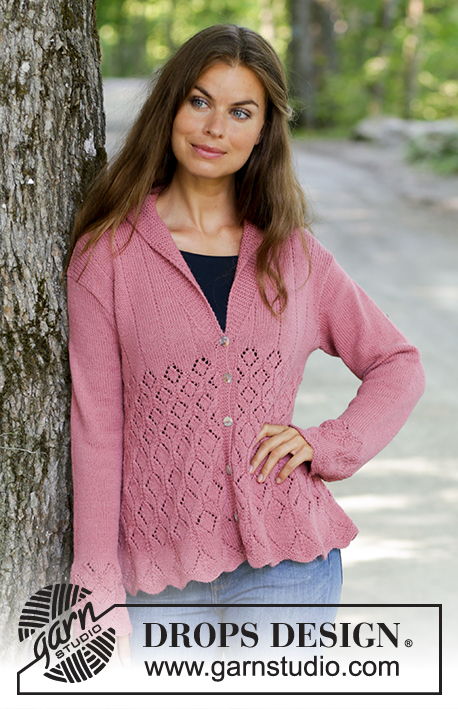 |
||||||||||||||||||
Knitted jacket in DROPS Nord. The piece is worked with lace pattern and shawl collar. Sizes S - XXXL.
DROPS 197-38 |
|||||||||||||||||||
|
------------------------------------------------------- EXPLANATIONS FOR THE PATTERN: ------------------------------------------------------- RIDGE/GARTER STITCH (worked back and forth): 1 ridge = Knit 2 rows. RIDGE/GARTER STITCH (worked in the round): 1 ridge = 2 rounds. Knit 1 round and purl 1 round. PATTERN: See diagrams A.1 to A.6. The diagrams show all the rows in the pattern seen from the right side. DECREASE TIP (for neck on front pieces): Decrease for neck on the inside of the 5 band stitches in garter stitch + the increased stitches for collar. All decreases are made from the right side! Decrease like this after the garter stitch on the band/collar: Slip 1 stitch as if to knit, knit 1 and pass the slipped stitch over the knitted stitch. Decrease like this before the garter stitch on the band/collar: Start 2 stitches before the garter stitch on the band/collar and knit 2 together. INCREASE TIP (for sleeves): Start 1 stitch before the stitch with marker thread, make 1 yarn over, knit 3 (marker thread sits in the middle stitch of these 3), make 1 yarn over (= 2 stitches increased). On the next round knit the yarn overs twisted to avoid holes. Then work the increased stitches in stockinette stitch. BUTTONHOLES: Work buttonholes on right band (when garment is worn). 1 buttonhole = Start from the right side and knit together the second and third stitch from the edge and then make 1 yarn over. On the next row (wrong side) knit the yarn over to leave a hole. Work buttonholes when the piece measures: S: 5, 12, 19, 26 and 33 cm = 2", 4¾", 7½", 10¼" and 13" M: 6, 13, 20, 27 and 34 cm = 2⅜", 5⅛", 8", 10⅝" and 13⅜" L: 7, 14, 21, 28 and 35 cm = 2¾", 5½", 8¼", 11" and 13¾" L/XL: 8, 15, 22, 29 and 36 cm = 3⅛", 6", 8¾", 11⅜" and 14¼" XXL: 7, 13, 19, 25, 31 and 37 cm = 2¾", 5⅛", 7½", 9¾", 12¼" and 14½" XXL/XXXL: 8, 14, 20, 26, 32 and 38 cm = 3⅛", 5½", 8", 10¼", 12½" and 15" ---------------------------------------------------------- START THE PIECE HERE: ------------------------------------------------------- JACKET – SHORT OVERVIEW OF THE PIECE: The piece is worked back and forth with circular needle, from mid front and bottom up as far as the armholes. Then the front and back pieces are finished separately, back and forth on circular needle. The sleeves are worked in the round with double pointed needles / short circular needle, bottom up. BODY: Cast on a little loosely 291-319-347-375-431-459 stitches with circular needle size 3.5 mm = US 4 and Nord. Work 3 RIDGES – read description above. Work 2 rows stockinette stitch with 5 band stitches in garter stitch in each side towards mid front. The next row is worked as follows from the right side: 5 band stitches in garter stitch, work A.1A until there are 6 stitches left on the row (= 20-22-24-26-30-32 repeats of 14 stitches), work A.1B (= 1 stitch) and finish with 5 band stitches in garter stitch. Continue this pattern. REMEMBER THE KNITTING GAUGE and work BUTTONHOLE on right band – read description above. When A.1 has been completed there are 251-275-299-323-371-395 stitches on the needle and the piece measures approx. 7 cm = 2¾" from the cast-on edge, measured on the longest part. The next row is worked as follows from the right side: 5 band stitches in garter stitch, work A.2A (= 6 stitches), A.2B until there are 12 stitches left on the row (= 19-21-23-25-29-31 repeats of 12 stitches), A.2C (= 7 stitches) and finish with 5 band stitches in garter stitch. Continue this pattern. When A.2 has been completed, work A.3A, A.3B and A.3C in the same way. When A.3 has been completed there are 211-231-251-271-311-331 stitches on the needle. The next row is worked as follows from the right side: 5 band stitches in garter stitch, work A.4A (= 5 stitches), A.4B until there are 11 stitches left on the row (= 19-21-23-25-29-31 repeats of 10 stitches), A.4C (= 6 stitches) and finish with 5 band stitches in garter stitch. Continue this pattern. When A.4 has been completed, work A.5A, A.5B and A.5C in the same way. When A.X in A.5 has been worked 1 time in height the piece measures approx. 32 cm = 12½" in all sizes. Insert 1 marker thread in the 56th-61st-66th-71st-81st-86th stitch in from each side (= 99-109-119-129-149-159 stitches between the stitches with marker threads on the back piece). Allow the marker threads to follow your work onwards; they will be used a little later when casting off for the armholes. Then work A.Y in A.5 to finished length. AT THE SAME TIME increase for collar and decrease for neck and armholes as described below – remember the last buttonhole on right band. Read COLLAR, NECK and ARMHOLES before continuing! COLLAR: When the piece measures 34-35-36-37-38-39 cm = 13⅜"-13¾"-14¼"-14½"-15"-15¼", starting from the right side, work 1 ridge back and forth over the 5 band stitches on the right band (the other stitches are not worked), then work 1 row from the right side as before over all stitches, turn and work 1 ridge back and forth over the 5 band stitches on the left band (without working the other stitches), then work 1 row from the wrong side as before over all stitches. Continue with pattern as before, back and forth, but now start to increase for the collar. Increase 1 stitch for the collar by making 1 yarn over inside the 2 outermost stitches in each side. On the next row knit the yarn overs twisted to avoid holes. Increase like this every 2nd row a total of 3 times and then every 4th row a total of 12-12-13-13-14-15 times (= 15-15-16-16-17-18 stitches increased for the collar on each side and a total of 20-20-21-21-22-23 garter stitches on each side including the band). NECK: AT THE SAME TIME when the piece measures 36-37-38-39-40-41 cm = 14¼"-14½"-15"-15¼"-15¾"-16⅛" decrease 1 stitch for the neck on the inside of the 5 band stitches in garter stitch + the increased stitches for collar on each side – read DECREASE TIP. Decrease like this every 2nd row a total of 3 times, every 4th row a total of 7 times and then every 6th row a total of 3-3-4-4-5-6 times (= 13-13-14-14-15-16 stitches decreased for neck in each side). ARMHOLES: AT THE SAME TIME when the piece measures 37-38-39-40-41-42 cm = 14½"-15"-15¼"-15¾"-16⅛"-16½" bind off for the armholes in each side as follows: Work from the right side as before until there are 3-3-3-4-4-4 stitches left before the stitch with the marker thread, bind off 7-7-7-9-9-9 stitches for the armhole, work as before until there are 3-3-3-4-4-4 stitches left before the second stitch with marker thread, bind off 7-7-7-9-9-9 stitches for armhole and work to end of row as before. Front and back pieces are finished separately. LEFT FRONT PIECE: Continue back and forth with garter stitch over collar/bands and A.Y over the other stitches (continue to increase for collar and decrease for neck as before). AT THE SAME TIME bind off for the armhole at the beginning of each row from the side as follows: Bind off 3 stitches 0-0-0-1-2-3 times, 2 stitches 1-2-3-3-4-4 times and 1 stitch 1-3-4-4-7-7 times. Continue working until the piece measures approx. 55-57-59-61-63-65 cm = 21⅝"-22½"-23¼"-24"-24¾"-25½" from the cast-on edge at the longest part. Knit 1 row from the wrong side over all stitches. On the next row bind off the first 31-32-33-34-35-36 stitches for shoulder = 20-20-21-21-22-23 garter stitches left on needle for collar, knit to end of row. Finish collar as described below. COLLAR LEFT FRONT PIECE: Start from the wrong side and work garter stitch back and forth as follows: * 1 ridge back and forth over all stitches, 1 ridge back and forth over the first 15-15-16-16-17-18 stitches *, work from *-* until the collar measures approx. 7-7-8-8-8-8 cm = 2¾"-2¾"-3⅛"-3⅛"-3⅛"-3⅛" along the shortest side (collar measures approx. 14-14-16-16-16-16 cm = 5½"-5½"-6¼"-6¼"-6¼"-6¼" outermost along the longest side). Bind off with knit from the right side. RIGHT FRONT PIECE: Continue back and forth with garter stitch over collar/band and A.Y over the other stitches (increases to collar and decreases for neck continue as before). AT THE SAME TIME bind off for the armhole at the beginning of each row from the side as follows: Bind off 3 stitches 0-0-0-1-2-3 times, 2 stitches 1-2-3-3-4-4 times and 1 stitch 1-3-4-4-7-7 times. Continue working until the piece measures approx. 55-57-59-61-63-65 cm = 21⅝"-22½"-23¼"-24"-24¾"-25½" from the cast-on edge on the longest part. Knit 1 row from the wrong side over all stitches. On the next row knit the first 20-20-21-21-22-23 stitches (= collar), and bind off the remaining 31-32-33-34-35-36 stitches for shoulder. Cut the strand and finish collar as described below. COLLAR RIGHT FRONT PIECE: Start from the wrong side and knit over all stitches, * turn the piece and work 1 ridge back and forth over the first 15-15-16-16-17-18 stitches, 1 ridge back and forth over all stitches *, work from *-* until the collar measures approx. 7-7-8-8-8-8 cm = 2¾"-2¾"-3⅛"-3⅛"-3⅛"-3⅛" along the shortest side and bind off with knit from the right side. BACK PIECE: = 93-103-113-121-141-151 stitches. Continue A.Y back and forth as before and bind off for the armholes at the beginning of each row in each side as follows: Bind off 3 stitches 0-0-0-1-2-3 times, 2 stitches 1-2-3-3-4-4 times and 1 stitch 1-3-4-4-7-7 times = 87-89-93-95-99-103 stitches on needle. When the piece measures 54-56-58-60-62-64 cm = 21¼"-22"-22¾"-23⅝"-24⅜"-25¼" bind off the middle 21-21-23-23-25-27 stitches for neck and each shoulder is finished separately. Bind off 2 stitches on the next row from the neck = 31-32-33-34-35-36 stitches left on shoulder. Continue working until the piece measures approx. 55-57-59-61-63-65 cm = 21⅝"-22½"-23¼"-24"-24¾"-25½" from the cast-on edge on the longest part. Knit 1 row from the wrong side. Bind off with knit from the right side. Work the other shoulder in the same way. The jacket measures approx. 56-58-60-62-64-66 cm = 22"-22¾"-23⅝"-24⅜"-25¼"-26" from the bind-off edge and down measured on the longest part. SLEEVE: Cast on a little loosely 60-60-60-72-72-72 stitches with double pointed needles size 3.5 mm = US 4 and Nord. Work 3 RIDGES in the round – read description above. Work 2 rounds stockinette stitch. Then work A.6 in the round (= 5-5-5-6-6-6 repeats of 12 stitches). When A.6 has been completed, work A.3B in the round (= 5-5-5-6-6-6 repeats of 12 stitches). Continue this pattern, but when there are 6 rounds left in A.3 work stockinette stitch over the one purled stitch in the pattern until A.3 has been completed. When A.3 is finished, there are 50-50-50-60-60-60 stitches on the needles and the piece measures approx. 12 cm = 4¾" from the cast-on edge on the longest part. Insert 1 marker thread in the first stitch on the round. Allow it to follow your work onwards; it will be used when you increase mid under sleeve. Work stockinette stitch in the round. When the piece measures 14-14-14-14-13-13 cm = 5½"-5½"-5½"-5½"-5⅛"-5⅛" increase 2 stitches mid under sleeve – read INCREASE TIP. Increase like this a total of 14-17-19-17-21-23 times - in S: Every 8th round, in M and L/XL: Every 6th round, in L: Alternately every 5th and 6th round, in XXL: Alternately every 4th and 5th round and in XXL/XXXL: Every 4th round = 78-84-88-94-102-106 stitches. Continue working until the sleeve measures 50-50-50-49-47-46 cm = 19¾"-19¾"-19¾"-19¼"-18½"-18" (shorter measurements in larger sizes due to wider shoulders and longer sleeve cap). The next round is worked as follows: Bind off 4-4-4-5-5-5 stitches, work 71-77-81-85-93-97 stitches in stockinette stitch and bind off the remaining 3-3-3-4-4-4 stitches. Cut the strand. Then work the sleeve cap back and forth with circular needle size 3.5 mm = US 4 as follows: Work stockinette stitch and bind off at the beginning of each row on each side as follows: Bind off 3 stitches 1 time in all sizes, 2 stitches 2-2-3-3-4-4 times and 1 stitch 1-2-4-4-7-10 times on each side, then bind off 2 stitches on each side until the piece measures 55-56-57-57-58-58 cm = 21⅝"-22"-22½"-22½"-22¾"-22¾". Bind off 3 stitches 1 time on each side and then bind off the remaining stitches. The sleeve measures approx. 56-57-58-58-59-59 cm = 22"-22½"-22¾"-22¾"-23¼"-23¼" from the top down. Work the other sleeve in the same way. ASSEMBLY: Sew shoulder seams inside the bind-off edge. Sew collar together mid back (make sure the seam is on the wrong side when the collar is folded down). Sew collar to neck at the back. Sew in sleeves inside the 1 edge stitch on each side. Sew buttons on to left band. |
|||||||||||||||||||
Diagram explanations |
|||||||||||||||||||
|
|||||||||||||||||||
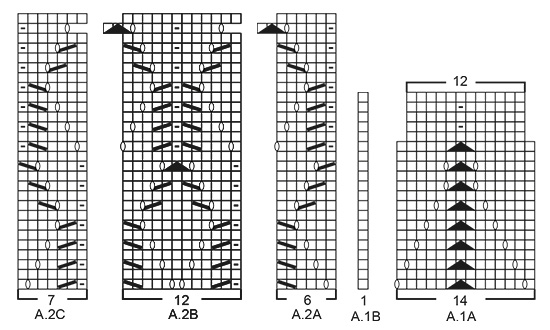
|
|||||||||||||||||||
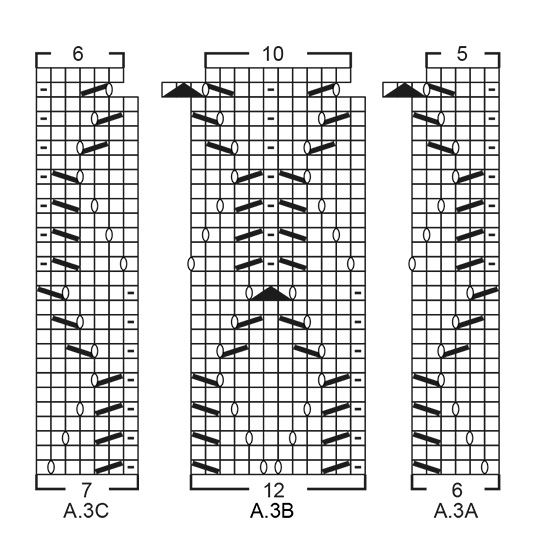
|
|||||||||||||||||||

|
|||||||||||||||||||
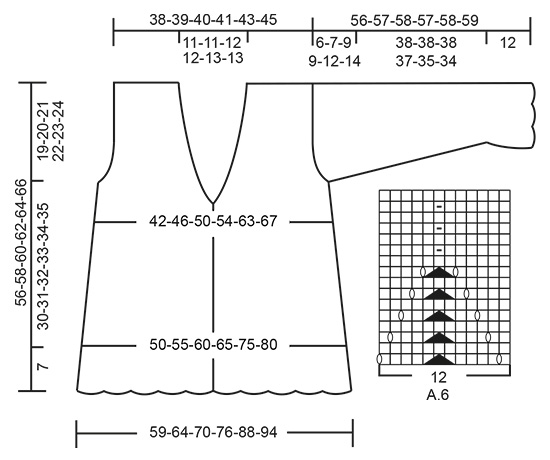
|
|||||||||||||||||||
|
Have you made this or any other of our designs? Tag your pictures in social media with #dropsdesign so we can see them! Do you need help with this pattern?You'll find tutorial videos, a Comments/Questions area and more by visiting the pattern on garnstudio.com. © 1982-2024 DROPS Design A/S. We reserve all rights. This document, including all its sub-sections, has copyrights. Read more about what you can do with our patterns at the bottom of each pattern on our site. |
|||||||||||||||||||







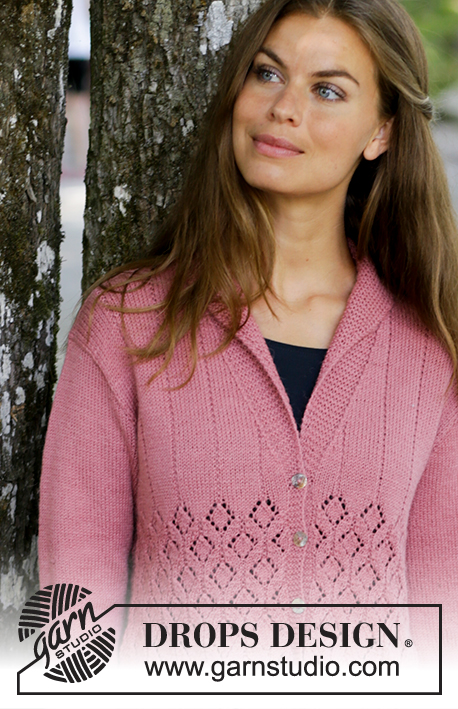



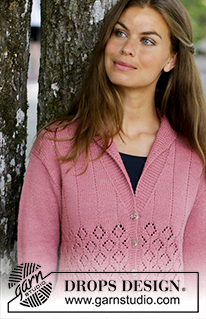
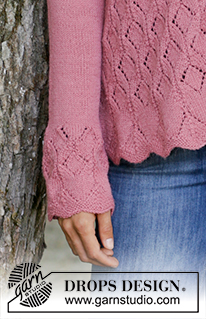


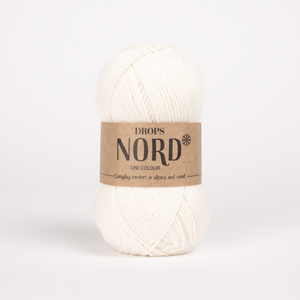
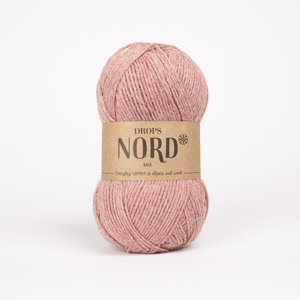












































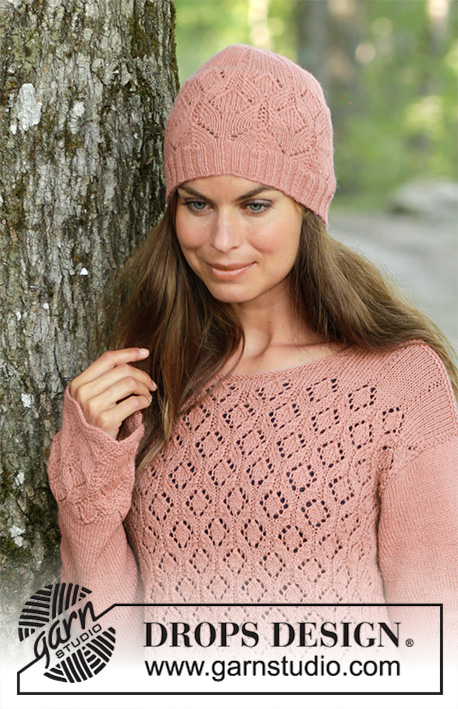

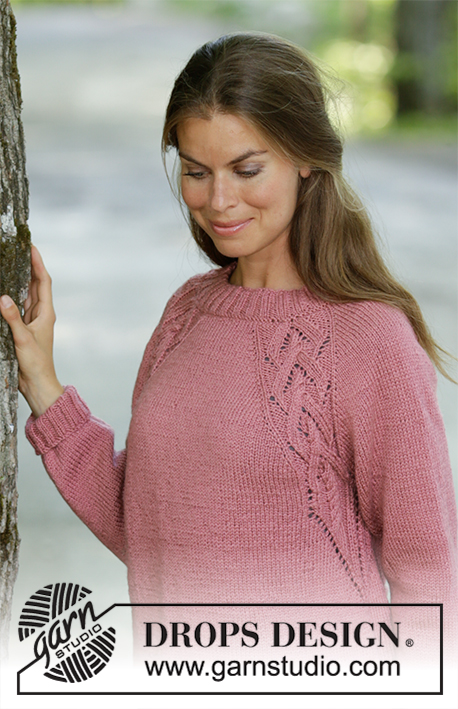






Comments / Questions (39)
Forstår ikke opskriften. Har flere masker efter 1. mønster, da der tages ud. Ifølge opskrift skal der være færre.
17.04.2024 - 23:19DROPS Design answered:
Hej Ingerlise, du starter nederst i diagram A.1A (strikker opad) og når du strikker pind 15 ifølge diagrammet, så tager du 2 masker ind for hver gang A.1A gentages. God fornøjelse!
18.04.2024 - 11:37Hej! Jag undrar vad A.X och A.Y betyder i mönstergrupp A5. Tacksam för svar.
12.01.2023 - 16:26DROPS Design answered:
Hei Ulla. Du strikker A.5 (A+B+C) og når du har strikket 20 rader av A.5 (A+B+C) som da også er A.X, måler arbeidet ca 32 cm i alle størrelser. Nå settes det et merke i arbeidet (les oppskriften). Videre strikkes det kun det som er merket med A.Y i A.5 (4 rader) til ferdig mål (A.Y gjentas til ferdig mål). mvh DROPS Design
16.01.2023 - 10:44Pour le diagramme A1, à partir du 16e rang jusqu’au 20e rang, les mailles 1 et 14 ne sont plus là, comment je les tricote pour arriver avec les autres mailles. Est ce que je dois les tricoter ensemble ?
24.02.2022 - 16:58DROPS Design answered:
Bonjour Mme Gagnon, en fait au 15ème rang, vous tricotez la double diminution (triangle noir) mais ne faites pas de jeté, autrement dit, vous allez diminuer 2 mailles dans chaque A.1A = il reste 12 mailles seulement. Bon tricot!
24.02.2022 - 17:07Ma première réalisation avec vos modèles gratuits. Je l'adore et je vous remercie de partager avec nous.
20.01.2022 - 15:41Bonjour.J\'ai un problème avec les manches de ce modèle, taille L/XL. A la fin de A3.B, j\'ai toujours 72 mailles et non 60 comme indiqué. Je pense qu'il ne faut pas faire les jetés à l\'avant dernier rang. Est-ce bien cela ? Merci par avance pour votre réponse.
15.12.2020 - 09:30DROPS Design answered:
Bonjour Mme Arlery, il faut bien faire les jetés pour terminer le motif ajouré, mais pensez à bien faire toutes les diminutions, glissez les 2 première m du tour (elles seront tricotées avec le dernier A.3B du tour): A.3B + les 2 premières m du A.3B suivant/de A.3C = il doit rester 10 m (on diminue 2 m par A.3B) et terminez le dernier A.3B en tricotant les 2 dernières m du tour avec la dernière m du dernier A.3B. Vous avez maintenant 10 m par A.3B x 6 motifs = 60 mailles. Bon tricot!
15.12.2020 - 14:45I have started work on the Collar Left Front Piece and cannot work out how to measure the collar along the shortest side. Which bit is the shortest side?
18.10.2020 - 06:26DROPS Design answered:
Dear Lilduine, the shorter side on short rows is the beg of rows from RS on left frong piece (= right side of collar seen from RS) ie the side where you worked less rows. Happy knitting!
19.10.2020 - 08:40Esta semana he terminado esta chaqueta y queda fenomenal. He escogido una tallamás pequeña, ya que me parece que las tallas quedan grandes. En vez de una M he tejido una S, además he tejido las mangas más cortas. Después de terminar la chaqueta la he lavado en agua tibia y lo he dejado secar en una toalla de playa en 48 horas. Queda así como en la fotografía. La lana me ha gustado mucho, pero ha sobrado bastante.
14.10.2020 - 17:48Perdón ya lo he entendido, gracias
24.09.2020 - 23:31Hola, Me gustaría que me dijeseis como reducimos puntos en los diagramas 2- 3-4...yo sólo reduzco en el 1 siguiendo los esquemas me salen los mismos puntos de principio a fin, por cada 2 puntos que dejo en 1 echo 1 hebra con lo cual al final me quedo igual
23.09.2020 - 19:28How many balls of yarn do I need for a medium sized jacket?
04.08.2020 - 17:23DROPS Design answered:
Dear Mrs Musenero, you will find amount of yarn at the very beginning of the pattern, together with the tension and needle sizes, this means in M you need 400 g divided by 50 g a ball Nord = 8 balls Nord are required in size M. Happy knitting!
05.08.2020 - 07:48